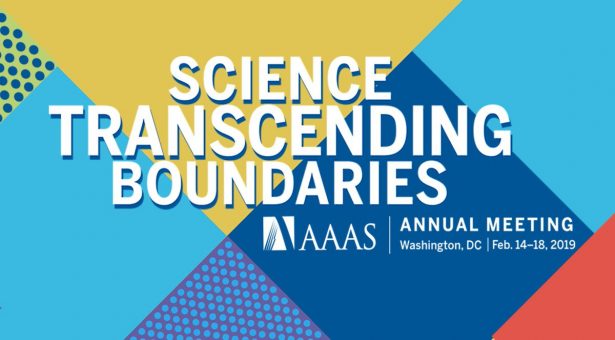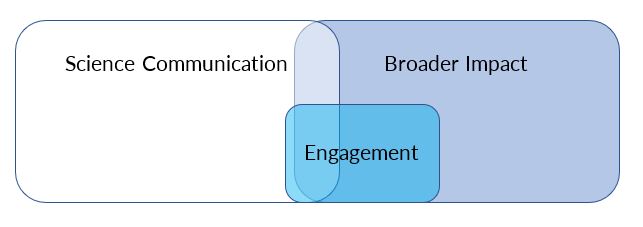What is science communication?

Following the 2019 AAAS General Meeting, our Head of Communication and Engagement, Dr Felicity Perry reflects on what she saw, heard and discussed at the “world’s largest scientific gathering”.
With a theme of ‘Science Transcending Boundaries’, this was the 185th meeting of AAAS, held this year in Washington DC, the location of the AAAS headquarters.
Before arriving in Washington, I read a lot about the conference and the American Association for the Advancement of Science, a membership organisation which seeks to “advance science, engineering, and innovation throughout the world for the benefit of all people”, with one of their key objectives being to “Enhance communication among scientists, engineers, and the public”.
And so off I went to Washington, where I found plenty of sessions to explore, find inspiration and get up-to-date with the latest thinking on science communication, engagement and impact.
This was my first TripleA-S (which is how everyone refers to it), it’s overwhelmingly large, but amazing to have so much to see and do in one place. Just choosing which session to go to is difficult when you’re spoilt for choice. Decisions though must be made.
Through the first two days the question ‘What is Science Communication?” comes up both as the introduction to a session, in workshops or over coffee. It got me thinking about writing a blog which explains what it is, and why it’s important.
So, what is Science Communication?
In its broadest sense, science communication is communicating science to a non-expert “audience”, also known as a lay-person.
When we talk about science communication we lump together all the STEMM (Science, Technology, Engineering, Maths and Medicine) subjects for ease. Most of the activities, techniques and research, (yes research) into the practice of science communication and engagement apply across the STEMM subjects – science communication is a catch all term.
‘Public engagement’ and ‘outreach’ are terms which often used interchangeably alongside and within science communication, but they mean slightly different things. The British Interactive Group (BIG) explains the nuances well, so I won’t repeat that here.
I think of science communication as a broad, slightly fuzzy, cloud of activities which involve using a range of tools to ensure that the science is communicated to who we want it to reach.
Here at the John Innes Centre, we have a small team dedicated to science communication and engagement. We work (tirelessly) to make sure that the research done here reaches the right people, plus we work to enable others in the organisation to communicate efficiently and effectively.
We strive to clearly explain the science and its impact, making it interesting, accessible, stimulating and thought provoking. This is science communication.
We communicate our science and it’s impact in a variety of ways, from written words, like this blog, a news article or features, or we may use spoken words; videos, presentations, phone calls, meetings or events to convey that same information.
As a researcher, science communication is also those conversations you have with your colleagues, or your friends and family. Or the discussions you have with someone at a dinner party when they say those dreaded words, ‘So, what is it that you do?’.
Then there is things like; social media, illustration, animation, SciArt, poetry and podcasts, all of which can transmit your work to a particular group of people.
So that’s what it is, but how do we do it?
Successful science communication considers three key things
1 – Who are you trying to communicate with?
In SciComm jargon, this is the audience. Thinking about who you want to communicate or engage with is paramount. Do you want to tell your colleagues, or the scientific community that you’ve written a paper? Or is it something that policymakers should know about? Perhaps you aim to inspire the next generation of scientists by telling them about your research? Knowing your audience is very important.
2 – What’s your key message?
If you had to boil it down, what’s the one thing that you want the person to know, understand or perhaps do as a result of this communication?
3 – How should we communicate that message?
This is the method, our tactics. What type of communication is most appropriate, and which is going to be most effective to reach our audience and tell our key message?
Once you know the who, the what and the how, you can start to communicate science.
What is the relationship between science communication and broader impacts?
A few times at 2019’s AAAS we had discussions, or speakers raised the topic of defining the boundaries where science communication becomes engagement, and how that ties in with broader impacts.
Broader Impacts is a term that the NSF (National Science Foundation – a US science funding body) use to assess and evaluate their grant proposals, as far as I can tell it is similar to the UKRI Pathway’s to Impact.
I like the US terminology because it helps to convey that the impact of a piece of science or research isn’t necessarily something easy to measure like economic impact, or number of jobs created.
Sometimes we aim to inform, or to change how people behave, make decisions or think about a topic. The range of impact we can have is broad, and they are all important in different circumstances.
One workshop session at AAAS asked us, does science communications equal broader impacts? Our group ended up discussing a board range of things, and not the intended question, but I think we agreed that the boundaries are blurry at best. As to where the lines between communications, engagement and impact lie I think that might be a topic which is too big for one blog.
In short, I think that science communication is the mostly the activity which leads to a broader impact, rather than the being the impact itself, although there are some instances where science communication can be directly impactful, but these are not so common.
True engagement is much more likely to lead to impact and may in time be very impactful.
By ‘engagement’ I mean to have a two-way relationship with the flow of information, to transmit and receive. A good example of an engagement activity is to build a working relationship with someone in a relevant government department. You may start by transmitting information to them, e.g. providing them a research summary, or by answering a question. But if you follow that up with a phone call or offer speak with them to clarify any points you start to build a relationship.
Over time you build trust and encourage the two way flow of information, and this might mean that they come to you for advice and evidence to inform a policy. Influencing a policy has impact.
I think the diagram below explains how the three concepts fit together in my understanding, but as this is a developing and dynamic field it may be out of date by the time this blog gets published.

That’s hyperbole, but there is still discussion of communication vs engagement and the old Public Understanding of Science/Public Engagement with Science model debate “rages” on.
By doing science communication you can have broader impact, and you can measure that in lots of different ways, but you must consider that science communication in itself may not have any impact.
Science communication may be the start, but it probably isn’t the end of your Pathway to Impact.
